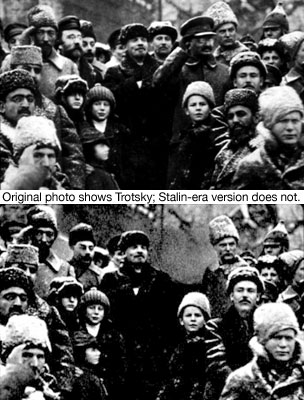In the late 1920s, Joseph Stalin's arch-rival Leon Trotsky
disappeared from Russian historical photos.
Rewriting history would have been much easier with the newest
version of Adobe Photoshop, part of the company's Creative Suite 5
software package.
Software has made it commonplace to place people or objects from a
photo onto new backgrounds. Photoshop CS5, though, does the opposite.
Its new Content-Aware Fill makes it easy to select something in a
photo, delete it, and automatically fill in the resulting gap.
 As Soviet-era historical photos
demonstrate, this isn't new. What's new is how easy it can be to do
well. The new Photoshop can remove lens flare, weeds from photos of
your lawn, traffic from a street scene, and more, replacing what you
don't want with a simulation of the surrounding background.
As Soviet-era historical photos
demonstrate, this isn't new. What's new is how easy it can be to do
well. The new Photoshop can remove lens flare, weeds from photos of
your lawn, traffic from a street scene, and more, replacing what you
don't want with a simulation of the surrounding background.
A new mixer brush lets your mouse or tablet mix multiple colours to
the desired degree of wetness. In the higher-priced extended edition,
new 3-D tools expand what was offered in the previous version. A
shadow-catcher feature simplifies adding shadows to 3-D images.
Adobe has also added a host of refinements to existing tools. For
example, edge selection is improved, and there's RAW image support for
a growing range of camera models.
More Than Just Photoshop
Though Photoshop is perhaps Creative Suite's best-known component,
the full suite packs in a range of other components for artists and
designers working in print or online. Each of the various CS5 editions
includes a different mix from 14 programs, four new online services,
and a new interactive web-design product - Adobe claims a total of 250
new features throughout the suite.*
One of these features got Adobe into a skirmish with Apple. Packager allows
developers to create apps for multiple smartphone models. Apple
modified its developer license agreement to ban such apps from its App
Store - along with those developed by other cross-platform tools -
claiming apps made by these tools aren't fine-tuned for the iPhone's
unique features.
Among the CS5 versions are packages aimed at print designers, web
designers, and video editors, along with a master collection that
bundles the complete Adobe tool kit.
Among the 250 new features: Adobe's InDesign page-design program now
adds multimedia and online features, letting page designers add
interaction, animation, music, and more to their pages without needing
to write programming code.
It also improves support for the ebook-standard ePub format, making
it attractive for designers looking to repurpose print publications for
digital publication as ebooks, emagazines, and online. Big improvements
to user interface and aspects like text flow and captioning make the
new version easier to learn and use.
The CS5 version of Adobe's Illustrator drawing program adds a
perspective grid tool and a bristle brush tool to mimic a physical
paintbrush, while making it possible to move drawings in and out of the
suite's new Flash Catalyst program to add interactive features. The new
Flash Catalyst program hopes to bring Flash's formerly programmer-only
interactive capabilities to designers.
Premiere Pro CS5 video editor promises improved performance,
particularly working with large, effect-heavy projects on midrange
hardware like laptops. The new version also plays nicer with other
manufacturers' programs, such as Apple's Final Cut Pro.
Adobe is putting increased emphasis on its web services, offering
various services free to CS5 users.
Be prepared to pay, however - Photoshop CS5 and the other suite
components sell on their own in the $699 to $999 range (upgrades: $199
to $349); various versions of the CS5 suite run between $1,299 to
$2,599 (upgrades: $499 to $899). Despite the cost, print, graphics,
web, and multimedia designers are going to want to upgrade to it.

2010 First published in Business in
Vancouver, August 17-23 2010, issue #1086

 As Soviet-era historical photos
demonstrate, this isn't new. What's new is how easy it can be to do
well. The new Photoshop can remove lens flare, weeds from photos of
your lawn, traffic from a street scene, and more, replacing what you
don't want with a simulation of the surrounding background.
As Soviet-era historical photos
demonstrate, this isn't new. What's new is how easy it can be to do
well. The new Photoshop can remove lens flare, weeds from photos of
your lawn, traffic from a street scene, and more, replacing what you
don't want with a simulation of the surrounding background.
